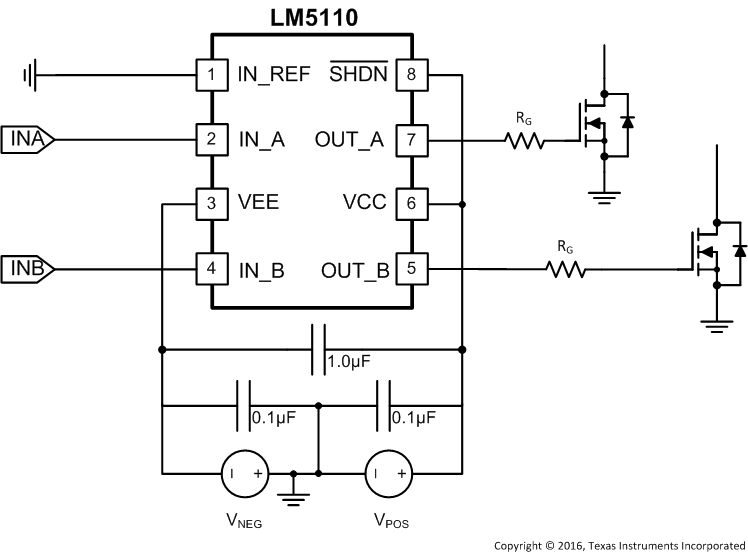SNVS255B May 2004 – September 2016 LM5110
PRODUCTION DATA.
- 1 Features
- 2 Applications
- 3 Description
- 4 Revision History
- 5 Device Options
- 6 Pin Configuration and Functions
- 7 Specifications
- 8 Detailed Description
- 9 Applications and Implementation
- 10Power Supply Recommendations
- 11Layout
- 12Device and Documentation Support
- 13Mechanical, Packaging, and Orderable Information
Package Options
Mechanical Data (Package|Pins)
Thermal pad, mechanical data (Package|Pins)
Orderable Information
1 Features
- Independently Drives Two N-Channel MOSFETs
- Compound CMOS and Bipolar Outputs Reduce Output Current Variation
- 5A sink/3A Source Current Capability
- Two Channels can be Connected in Parallel to Double the Drive Current
- Independent Inputs (TTL Compatible)
- Fast Propagation Times (25-ns Typical)
- Fast Rise and Fall Times (14-ns/12-ns Rise/Fall With 2-nF Load)
- Dedicated Input Ground Pin (IN_REF) for Split Supply or Single Supply Operation
- Outputs Swing from VCC to VEE Which Can Be Negative Relative to Input Ground
- Available in Dual Noninverting, Dual Inverting and Combination Configurations
- Shutdown Input Provides Low Power Mode
- Supply Rail Undervoltage Lockout Protection
- Pin-Out Compatible With Industry Standard Gate Drivers
- Packages:
- SOIC-8
- WSON-10 (4 mm × 4 mm)
2 Applications
- Synchronous Rectifier Gate Drivers
- Switch-Mode Power Supply Gate Driver
- Solenoid and Motor Drivers
3 Description
The LM5110 Dual Gate Driver replaces industry standard gate drivers with improved peak output current and efficiency. Each “compound” output driver stage includes MOS and bipolar transistors operating in parallel that together sink more than 5A peak from capacitive loads. Combining the unique characteristics of MOS and bipolar devices reduces drive current variation with voltage and temperature. Separate input and output ground pins provide Negative Drive Capability allowing the user to drive MOSFET gates with positive and negative VGS voltages. The gate driver control inputs are referenced to a dedicated input ground (IN_REF). The gate driver outputs swing from VCC to the output ground VEE which can be negative with respect to IN_REF. Undervoltage lockout protection and a shutdown input pin are also provided. The drivers can be operated in parallel with inputs and outputs connected to double the drive current capability. This device is available in the SOIC-8 and the thermally-enhanced WSON-10 packages.
Device Information(1)
| PART NUMBER | PACKAGE | BODY SIZE (NOM) |
|---|---|---|
| LM5110 | SOIC (8) | 4.90 mm × 3.91 mm |
| WSON (10) | 4.00 mm × 4.00 mm |
- For all available packages, see the orderable addendum at the end of the data sheet.
Simplified Application Diagram

4 Revision History
Changes from A Revision (November 2012) to B Revision
- Added ESD Ratings table, Feature Description section, Device Functional Modes, Application and Implementation section, Power Supply Recommendations section, Layout section, Device and Documentation Support section, and Mechanical, Packaging, and Orderable Information section Go
- Added Thermal Information table. Go